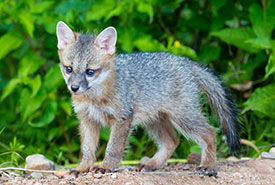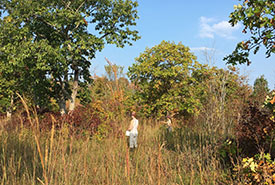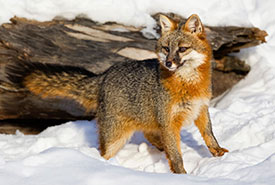NCC's Pelee Island fox squad on a mission to clean up Ontario's deep south

Gray fox pup (Photo by Ken Canning)
Making homes for Ontario’s rare and elusive gray fox takes a lot of work. In the fall of 2017, the Nature Conservancy of Canada’s (NCC’s) Pelee Island fox squad travelled to the island in the province’s deep south to do some house cleaning.
Unfortunately, what we found were alien invaders! A plant called Amur honeysuckle, which is an invasive (meaning that it does not belong in Ontario) non-native shrub, had infested much of the area, which is prime gray fox habitat. So, we rolled down our sleeves — to protect against ticks, of course — got out our loppers (scissors used for pruning twigs and branches) and hatchets and spent many long days chopping down the honeysuckles.
It was hard work, especially where the shrubs were thick. We often lost sight of each other and had to call back and forth to each other (it was like playing Marco Polo!), both to make sure that we didn’t get lost and that we were working in the right direction.
While the team worked close to a known fox den, the sly species hid from NCC staff. But hopefully, they appreciated the clean-up job.

Conservation Volunteers collecting seeds (Photo by NCC)
By getting rid of invasive plants, like honeysuckle and lilac, NCC is encouraging native plants to grow back. One way we help is by collecting seeds from one part of the island and planting them where we’ve removed invasive species or on what were once farm fields. The team spent many days in late summer/early fall collecting seeds from species like gray-head prairie coneflower, foxglove beardtongue and Canada wild rye.
Once collected, the seeds were set out to dry and de-spider, meaning we had let the spiders crawl away (we accidentally collected a lot of spiders because they’re on the seeds). The dried seeds were then picked over to remove the husks and stems, as this makes the seeds easier to store and plant.
The seeds were then planted using a broadcast seeder. This machine flings the seeds in every direction like a sprinkler. It makes it easier to cover more ground in less time, ensuring the seeds are spread evenly over the field. Hopefully, in the spring of 2018 the field will be filled with wild, native flowers.

Gray fox (Photo by Ken Canning)
You might wonder how cutting down unwanted plants and planting native ones help the gray fox. Foxes, like most species, are dependent on specific habitat to survive. Like us, foxes need certain things to make a happy home: food, water and shelter for their babies. By making sure that NCC’s conservation areas have many native plants, we’re encouraging other animals — like rabbits, voles and wild turkeys — to return to the area. These species in turn are food for gray foxes and their young.
It’s important that we keep our natural areas as they were meant to be — wild and native!
Thank you to Earth Rangers for helping protect gray fox habitat on Pelee Island.

